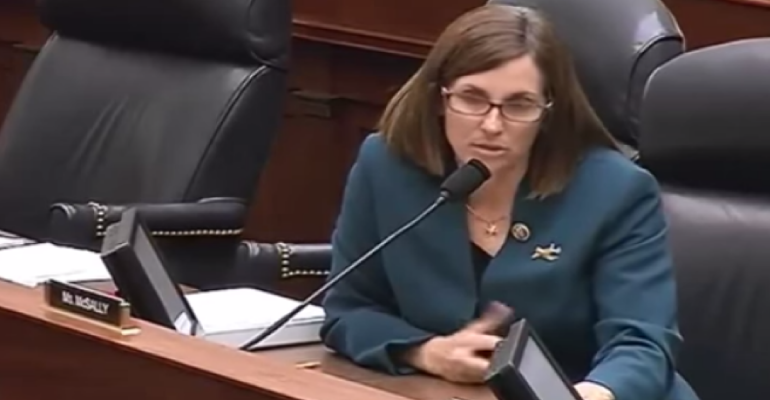
Welsh to visit Davis Monthan next week
On the heels of the United States Air Force Close Air Support Summit public relations disaster, Arizona Congresswoman, and former A-10 pilot Martha McSally exposed Secretary of Air Force Debra James and Air Force Chief of Staff, General Mark Welsh.
Following the same line of questioning by her predecessor Congressman Ron Barber last year, McSally asks James and Welsh, if given unlimited funds would they save the A-10. The two scramble and fall over each other in their effort to dodge the question.
Capitol Hill experts were disappointed that McSally, a novice on the Hill battlefield allowed General Raymond Odierno, the Army Chief of Staff, to back peddle on his former statements about the A-10. Last year, under questioning before the Senate Armed Services Committee, Odierno said that the “A-10 is the best close air support platform we have today.”
Many are chalking Odierno’s statements today to an I’ll-scratch-your-back-if-you-scratch-mine deal. Each service is supporting the efforts of the other in order to sell their wish lists to Congress and the public.
On February 27, Welsh, James and members of the JTAC community met at the Pentagon to discuss Close Air Support and the role of the A-10. According to Charlie Keebaugh, former JTAC and head of the TACP Association, Welsh and James met at the request of JTACs, who were concerned about the USAF plans to mothball the A-10.
Keebaugh, a Ranger qualified JTAC who served on active duty for 10 years as an Air Force JTAC and TACP Instructor, was joined by two Silver Star winners and one 30 year Chief Master Sergeant among others in the hour long meeting with James and Welsh. He described the at times tense meeting in a recent interview on the James T. Harris radio show out of Tucson, AZ. (Listen to interview here.)
Keebaugh said after today’s testimony, “In response to Rep McSally’s question as to whether or not the A10 is the best CAS platform, General Odierno responded, “only in Iraq and Afghanistan.” Ironically, these are also the two primary locations in which the US is conducting CAS since 9/11.
“The Army Chief of Staff, who has the most riding on the Air Force’s ability to provide CAS assets, stated that the A10 is the best. The Air Force should listen closely and reconsider,” warned Keebaugh. “The JTAC Community has echoed the exact same statement repeatedly. These guys are on the front line in every conflict, in whatever country around the world. They are the ones, often under fire, who have to coordinate multiple CAS assets to find and engage the enemy. Mistakes can be catastrophic. It takes a very well trained team to execute these missions. Unfortunately, after thousands of successful engagements, it starts to look easy. Any platform must be able to do it, right?”
“Decision makers on this subject should step outside the wire and see first hand the differences that exist among the various aircraft. When bullets start flying, the will see first hand that no other platform can provide the A10’s battlefield capability and no other platform contributes as much to the close fight as the A-10,” continued Keebaugh.
“After 14 years in Afghanistan and 12 years in Iraq, the data is clear, the A-10 is vital to our nation’s success. The Air Force can skew the statistics all they want on some PowerPoint slide, but the warriors who are being sent into harm’s way are screaming that this is a mistake that will cost American lives unnecessarily.” Keebaugh concluded, “Someone should listen.”
U.S. Senator John McCain (R-AZ), Chairman of the Senate Armed Services Committee, questioned the Air Force and army today at a hearing on the postures of the Department of the Army and the Department of the Air Force in review of the Defense Authorization Request.
The Committee met today to consider the posture of the Army and Air Force in the context of the Senate’s review and oversight of the FY2016 defense budget request.
McCain called the Air Force budget request to retire 164 A-10 aircraft in FY16 before the F-35 is fully operational “confusing.’ McCain asked, “If the Air Force cannot afford to lose capacity, why is it volunteering to retire its most proven aircraft for close air support missions?”
On his popular website, John Q. Public, Distinguished Flying Cross winner Tony Carr noted that “the subject of modernization promises to be front and center” of the hearings. “Core to that discussion will almost certainly be the limping, $1.4 trillion F-35 program,” writes Carr. “The bloat of the program is now placing increasingly excruciating pressure on the entire Air Force budget, this despite the F-35 being years from genuine operational capability. The pressure it is exerting is leading to a parade of rhetorical and actual absurdity of the variety that should, under normal circumstances, alarm Congress and anyone else concerned about the future of American defense.”
To that end, Welsh is visiting Davis Monthan Air Force base, home of the 357th Fighter Squadron which trains pilots in the A-10 and Thunderbolt II. Welsh will visit for “base familiarization,” according to a USAF spokesperson. “His orientation includes meeting with Airmen, base leadership, and local key leaders.”
It is believed that the Air Force is eyeing Davis Monthan for a round of BRACs, and Welsh will likely offer, a handful of Vipers in the short term, and trinkets to the leaders of the community to win their cooperation. Welsh has been the CSAF since August 2012, and the fact that he is just now visiting has raised questions as to his real motivations. It is believed that he is trying to pacify Senator Jeff Flake and McSally, who have previously offered weak support for the base and the A-10.
One Hill source said with frustration, “He is probably hoping the “local key leaders” will voice opposition to the F-35, will make it easy for them to cross Tucson off the list.”
